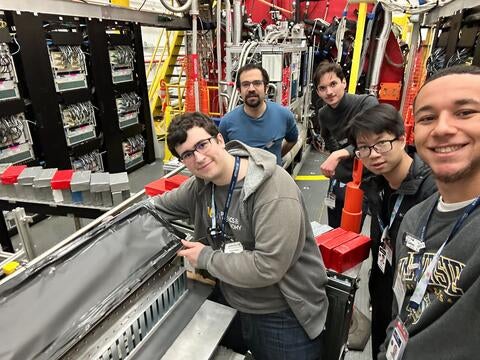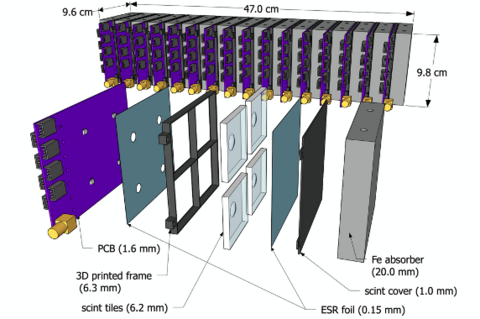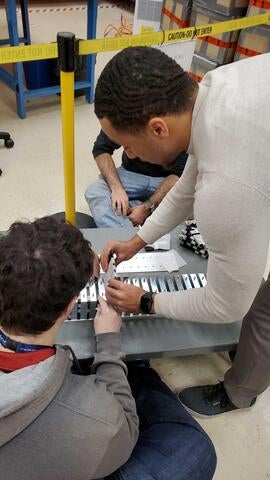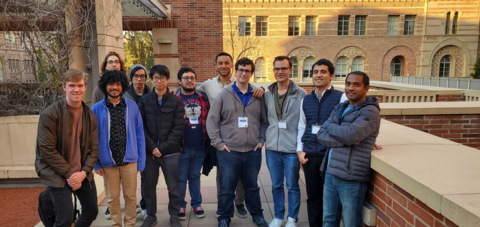A group of young physicists at the University of California, Riverside, recently acquired the kind of invaluable hands-on experimental nuclear physics experience that is sure to make their resumes stand out.
With the prototype at JLab. From L to R: Sean Preins, Sebouh Paul, Bruce Bagby, JiaJun Huang, and Peter Carney. (UCR/Arratia lab)
Three undergraduate students were joined by a graduate student and a postdoctoral researcher in building a prototype for a detector design proposed for the future Electron-Ion Collider, or EIC, at Brookhaven National Laboratory. The EIC aims to study the properties of the proton and produce its first ever 3D image.
The physicists, advised by Miguel Arratia, an assistant professor of physics and astronomy at UCR, travelled in early January to Thomas Jefferson National Laboratory, or JLab, in Virginia to set up their prototype detector that measures the energy and angle of high-energy particles produced in high-energy nuclear reactions.
The prototype uses a “sandwich” structure of iron plates and scintillating plastic tiles or boards. When particles pass through it, the scintillator material emits light which is measured by silicon photomultipliers.
“The experience at JLab has provided these physicists with a well-rounded education in experimental physics, which includes the complete cycle of designing, prototyping, testing, and fabricating the detector in addition to running experiments and analyzing data,” Arratia said. “This can be a transformative experience for them because they were in the driver’s seat in this project, using a unique facility and a detector they built themselves.”
The physicists carried out the experiments from end to end. They first constructed the prototype in Arratia’s lab at UCR. They then completed its construction in the experimental hall at JLab and performed a variety of tests in situ. They are now analyzing the data they collected, which will help refine the design and construction techniques used to build the prototype.
Schematic shows details of the prototype. (UCR/Arratia lab)
“We plan to take our prototype to Brookhaven National Laboratory at some point,” said postdoctoral researcher Sebouh Paul, who is based in Virginia. “The testing at JLab is the first of many tests. We also plan to test the detector at Fermi National Laboratory.”
The physicists have worked on the project for more than six months. The prototype, which weighs about 90 pounds is designed to measure a variety of particles. At JLab, it is situated in front of a positron beam, allowing the physicists to test if it is working properly. The prototype’s true test, however, will be detecting particles called hadrons that are produced in particle collisions.
“The prototype’s purpose is to measure the angles and energy of incoming hadrons,” said third-year graduate student Sean Preins. “In the EIC, collisions will produce many types of particles outgoing in different directions. To reconstruct what happens at the time of collision, you need to see what exactly emerges from that collision.”
At Fermilab, a larger version of the prototype will measure pions, a type of hadron. At Brookhaven National Laboratory the plan is to measure a high flux of neutrons, which also are hadrons.
“This is cutting-edge physics,” Preins said. “Much of it has to do with scientific explorations about which we don’t have much knowledge. Currently, we are faced with many mysteries surrounding the inner workings of the proton. With technology, we are finally trying to uncover some of them. This is a good time to be working in this exciting field.”
The physicists are seen here finishing the assembly of the detector at JLab by inserting scintillator material in between iron blocks. (UCR/Arratia lab)
Undergraduates Peter Carney and Bruce Bagby had no hesitation in joining the research team.
“I got interested because the project involved physically constructing the detector,” said Carney, the most recent member of the group. “Soldering, making the tiles and cables, and then putting all the pieces together. It was great to see it all come to fruition layer by layer.”
Undergraduate JiaJung Huang wasn’t sure at first about what he was getting involved in, but with time his interest soared.
“I never pictured myself building a prototype for a detector that would be put on a beam test, producing data I can analyze,” he said. “It has been fascinating to me to learn how to do that.”
Bagby’s initial interest stemmed from wanting to understand how experimentalists do physics.
“The collaborations to get projects in experimental physics going, such as building a detector, are interesting to me,” he said. “Our prototype is very innovative and modular. And we built it using accessible items, like a 3D printer.”
The other members of the group agreed with Bagby.
“Technology allows us to build really advanced systems,” Paul said. “We used many off-the-shelf components and 3D printing to build our prototype.”
Building the prototype was accompanied with occasional problems that the group quickly addressed and solved.
“It is really a series of troubleshooting,” Bagby said. “You run into all kinds of trouble but you fix the problems with easy solutions.”
Carney agreed that unexpected problems come up all the time.
“If I don’t solder a board correctly, it could mess up the integrity of the detector,” he said. “It’s a good thing they teach you in class to be a problem solver.”
Miguel Arratia, second from right, is seen with his research group at the California EIC consortium at UCLA. (UCR/Arratia lab)
Preins, Carney, Huang, and Bagby recently presented their work at the California EIC consortium at UCLA.
Arratia is pleased the members of the group complement each other’s strengths and have formed a close-knit cohort.
“Such experience can help students find their love for research and their path in science,” he said. “I am delighted to see this group having fun, and grateful for having been given the means to support them.”
The project was supported by the Multicampus Research Programs and Initiatives of the University of California Office of the President (award number 00010100); a High Energy Physics Consortium for Advanced Training fellowship from the Department of Energy, or DOE (award number DE-SC0022313); and a DOE traineeship award (award number DE-SC0022526).
AUTHOR: IQBAL PITTALWALA



